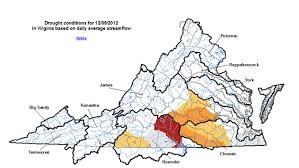A deepening drought in central and western North Carolina and Virginia has led U.S. Army Corps of Engineers Wilmington District to take action to declare drought conditions at John H. Kerr Dam and Reservoir this week.
“We don’t see any significant rain in the forecast for December and Kerr Lake levels continue to drop,” said Tony Young, water management chief for the Corps’ Wilmington District.
“North Carolina and Virginia drought monitoring groups, along with District water management stakeholders, have been watching dry conditions across the Roanoke River basin this summer and fall, and all agree that drought conditions have reached significant levels,” said Young.
While there was seemingly decent rainfall at Kerr Dam this summer, keeping the lake full depends on widespread rainfall across the entire Roanoke River basin, but this has not been the case this year.
“Since the end of June, inflows into Kerr have only averaged about 35 percent of normal,” Young said. “Since dropping below our target summer pool elevation at the end of June, we have been conserving water by only generating the minimum energy amount that we are contractually obligated to provide to scores of communities and electric cooperatives across Virginia and North Carolina.”
Since October, rainfall and inflows have been even less. November has been especially dry, with only a half-inch of rain in the basin and at the dam–as a result inflows were only about 20 percent of normal and were comparable to 2001 when inflows were the lowest on record for November.
As a further indication of worsening drought conditions, the National Drought Monitor downgraded much of N.C. and Va., including all of the Roanoke Basin above Kerr, to “D1-Moderate Drought” based on continued much-below normal rainfall and stream flows.
“Continued lake level decline is likely as long as dry conditions continue in the Roanoke Basin; however, winter is the normal recharge period for reservoirs and wells, so we will hopefully see some improvement in lake levels during the upcoming months, Young said.
The winter forecast calls for equal chances of below-normal, near-normal, and above-normal precipitation. If conditions improve to at least 50 percent of normal inflows in the upcoming months, lake levels would begin to improve.
“Until conditions improve, we will continue to generate “minimum” energy amounts,” Young said. “If conditions worsen, a reduction in generation below those minimum levels is a possibility.”
In response to the drought conditions, the district’s water management group is stepping up stakeholder coordination. “We are taking advantage of our weekly water management stakeholder conference calls that the district began in 2002 in response to a serious drought,” Young said. “The information we share helps us to make the best possible decisions for all who use water resources in our river basins.”
“Caution should be exercised by people who use John H. Kerr for recreation,” says Michael Womack, operations manager at John H. Kerr Reservoir. “When water levels get low, additional hazards like submerged debris, stumps and rocks are hidden just below the surface. Boaters should slow down, be alert and wear their life jackets at all times.”
Kerr Reservoir currently has several boat ramps closed due to low water levels. For the latest information on lake elevations and ramp closures, please call the John H. Kerr Powerhouse 24-hour recording line at 434-738-6633, ext. 275. You may also contact any park ranger at the Visitor Assistance Center, 434-738-6143, Monday – Friday.
Web Links For Additional Information: U.S. Army Corps of Engineers, Wilmington District



